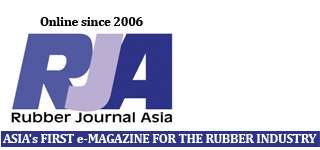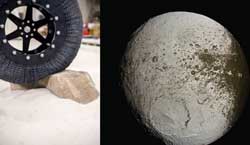US space agency NASA might soon change the way we drive on planet Earth. At its Glenn Research Centre in Cleveland, Ohio, engineers have developed a groundbreaking wheel technology designed for tackling extreme conditions on the Moon and Mars. Now, that same technology, the Superelastic Tire, could be used on tyres for bicycles, cars, and even heavy-duty vehicles.
Facing unusual engineering challenges such as sharp rocks as well as the absence of air that make traditional rubber tyres impractical, NASA developed Superelastic Tire, a wheel that doesn’t need air, can’t go flat, and can endure immense stress without failing.
It was originally tested for NASA’s Lunar Roving Vehicle and later for potential use in Mars rovers.
Superelastic Tire is made primarily from a nickel-titanium alloy, the same family of materials used in surgical stents and eyeglass frames that can bend and recover. This alloy exhibits a property called superelasticity, allowing it to deform under high strain and then revert to its exact original form when the force is removed.
Unlike conventional tyres filled with pressurised air, NASA’s tyres rely on the flexibility of the metal itself. Every coil and mesh structure in the tyre absorbs shocks and adapts to terrain.
In simple terms, it acts like a metal spring rather than a balloon. Even when crushed or bent under heavy weight, the tyre rebounds instantly, with no inflation required.
NASA researchers have demonstrated that these tyres can withstand temperatures ranging from -100°C to +200°C, meaning they could perform in extreme cold or heat, from Martian frost to desert roads on Earth.
Now, NASA is exploring how this technology could benefit ordinary use tyres, with the agency licensing the Superelastic Tire design to commercial manufacturers for adoption by consumer vehicles.
The goal is to build airless, puncture-proof, and maintenance-free tyres for bicycles, cars, and possibly even industrial machinery.
Early prototypes for bicycles have already been tested, demonstrating excellent shock absorption and road performance. For automobiles, NASA engineers are collaborating with tyre companies to create scalable versions capable of supporting higher speeds and heavier loads while maintaining fuel efficiency and comfort.
If commercialised, these tyres could drastically reduce waste, eliminating millions of discarded rubber tyres each year, and save drivers both money and time spent on maintenance.
Shape memory alloys are among the most advanced materials in modern engineering. They are lightweight, corrosion-resistant, and capable of undergoing large reversible deformations. When used in tyre construction, they provide key advantages:
· No air, no punctures: Eliminating air chambers means no blowouts, leaks, or pressure loss.
· Longer lifespan: Metal mesh construction can last far longer than rubber tyres, which degrade under sunlight and wear.
· Sustainability: Fewer replacements mean less environmental waste.
· Performance consistency: Tyre pressure never changes, ensuring predictable handling and safety.
NASA’s engineers describe these materials as “near-indestructible” in space conditions — and that durability could translate into one of the most significant automotive advancements of the decade.
Still, the Superelastic Tire faces hurdles such as scaling the technology for mass production is complex and costly. Nickel-titanium alloys are expensive to manufacture, and the specialised processes used by NASA must be adapted for high-volume output.
Another challenge lies in balancing flexibility with comfort. Metal tyres behave differently from rubber, and engineers are still refining ways to ensure smooth, quiet rides at highway speeds.
Regulatory testing, road safety certification, and integration with existing vehicle systems are also essential before airless metallic tyres can reach consumers.

